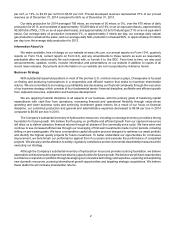Chesapeake Energy 2014 Annual Report Download - page 20
Download and view the complete annual report
Please find page 20 of the 2014 Chesapeake Energy annual report below. You can navigate through the pages in the report by either clicking on the pages listed below, or by using the keyword search tool below to find specific information within the annual report.12
In 2013 and 2012, we sold substantially all of our midstream business, including most of our gathering assets.
We continue to own the following midstream assets: (i) certain gathering pipelines primarily associated with vertical
well production in the northeastern United States; and (ii) four natural gas processing facilities located in West Virginia.
See Note 16 of the notes to the consolidated financial statements included in Item 8 of Part II of this report for further
discussion of the midstream sales transactions.
Compression Operations
Since 2003, we have operated our compression business through our wholly owned subsidiaries Compass
Manufacturing, L.L.C. (Compass) and MidCon Compression, L.L.C. (MidCon). Compass designs, engineers, fabricates,
installs and sells natural gas compression units, accessories and equipment used in the production, treatment and
processing of oil and natural gas. Once the compressors are complete, a majority of the completed compressors are
sold to MidCon. MidCon operates wellhead and system compressors, with approximately 500,000 horsepower of
compression, to facilitate the transportation of natural gas primarily produced from Chesapeake-operated wells.
Spin-Off of Oilfield Services Business
On June 30, 2014, we completed the spin-off of our oilfield services business, which we previously conducted
through our indirect, wholly owned subsidiary Chesapeake Oilfield Operating, L.L.C. (COO), into an independent,
publicly traded company called Seventy Seven Energy Inc. (SSE). See Note 13 of the notes to our consolidated financial
statements included in Item 8 of Part II of this report for additional information regarding the spin-off.
Following the spin-off, we have no ownership interest in SSE. Therefore, we ceased to consolidate SSE’s assets
and liabilities as of the spin-off date. Because we expect to have significant continued involvement associated with
SSE’s future operations through the various agreements described in Note 13 of the notes to our consolidated financial
statements included in Item 8 of Part II of this report, our former oilfield services segment’s historical financial results
for periods prior to the spin-off continue to be included in our historical financial results as a component of continuing
operations.
Competition
We compete with both major integrated and other independent oil and natural gas companies in all aspects of
our business to explore, develop and operate our properties and market our production. Some of our competitors may
have larger financial and other resources than ours. Competitive conditions may be affected by future legislation and
regulations as the United States develops new energy and climate-related policies. In addition, some of our competitors
may have a competitive advantage when responding to factors that affect demand for oil and natural gas production,
such as changing prices, domestic and foreign political conditions, weather conditions, the price and availability of
alternative fuels, the proximity and capacity of natural gas pipelines and other transportation facilities, and overall
economic conditions. We also face indirect competition from alternative energy sources, including wind, solar and
electric power. We believe that our technological expertise, our exploration, land, drilling and production capabilities
and the experience of our management generally enable us to compete effectively.
Regulation - General
All of our operations are conducted onshore in the United States. The U.S. oil and natural gas industry is regulated
at the federal, state and local levels, and some of the laws and regulations that govern our operations carry substantial
administrative, civil and criminal penalties for non-compliance. Although we believe we are in material compliance with
all applicable laws and regulations, and that the cost of compliance with existing requirements will not have a material
adverse effect on our financial position, cash flows or results of operations, such laws and regulations could be, and
frequently are, amended or reinterpreted. Additionally, currently unforeseen environmental incidents may occur or past
non-compliance with environmental laws or regulations may be discovered. Therefore, we are unable to predict the
future costs or impact of compliance or non-compliance. Additional proposals and proceedings that affect the oil and
natural gas industry are regularly considered by Congress, the states, local governments, the courts and federal
agencies, such as the U.S. Environmental Protection Agency (EPA), the Federal Energy Regulatory Commission
(FERC), the Department of Transportation (DOT), the Department of Interior (DOI) and the U.S. Army Corps of Engineers
(USACE). We actively monitor regulatory developments applicable to our industry in order to anticipate, design and
implement required compliance activities and systems.
























